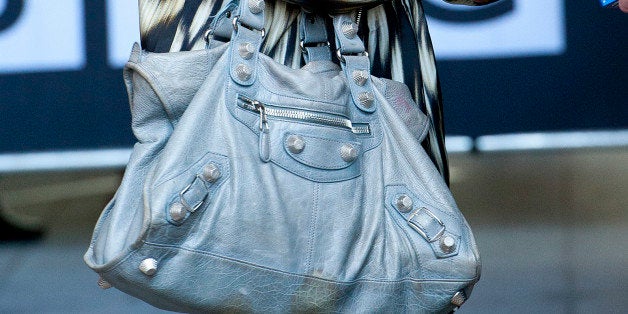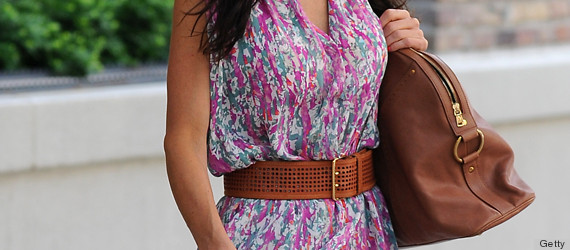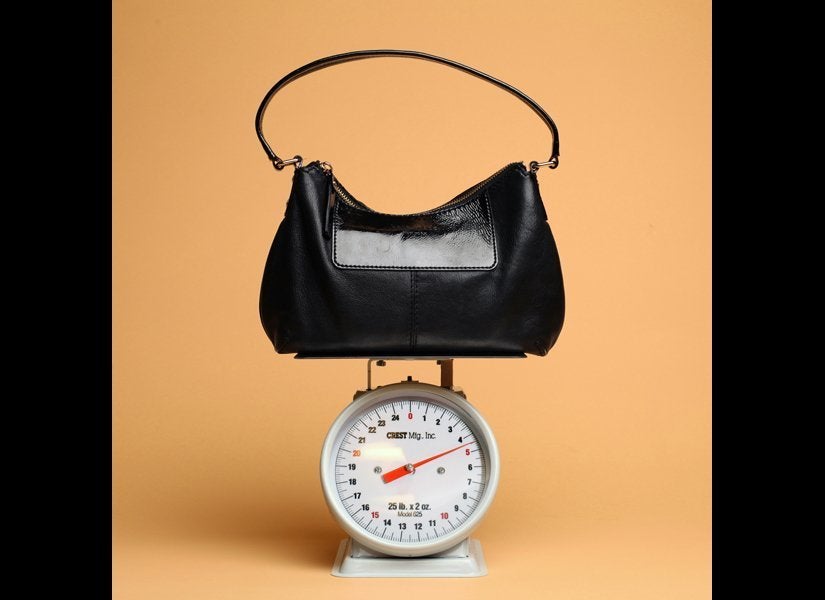
According to the American Chiropractic Association, half of working Americans admit to having back pain. What's more, our nation as a whole is spending at least $50 billion each year to remedy that pain. One culprit? Our heavy purses.
We spoke to Dr. Robert A. Hayden, a chiropractor and founder of The Iris City Chiropractic Center in Atlanta, and New York-based chiropractor Dr. Karen Erickson to find out just why our beloved handbags are harming our backs and what we can do to avoid all of the discomfort -- and perhaps save some cash in the process.
When You Carry A Heavy Purse...
♦ Your natural gait is thrown off. "One of the consequences of carrying a shoulder bag on one shoulder is that it significantly interferes with the normal gait," says Dr. Erickson. The gait is the way your arms and legs swing when you walk naturally, and it's an important way to keep your body balanced. When you put a handbag on one side of the body, it means the arm on that side can't swing properly and the other arm has to swing more. People can develop problems because of that, she says.
♦ Your muscles are off balance. Since all of the weight of your bag is on one shoulder, you're carrying an asymmetric load, which throws off your posture. Most people tend to carry purses on their side of dominance -- if you're right-handed, you'll hang it over your right shoulder. But this causes the muscles in your dominant shoulder, particularly the trapezius muscle, to become bigger. "We see asymmetry in posture -- like, one shoulder's higher than the other -- from this chronic forcing of the muscles on one side to become more developed than the muscles on the other side," Dr. Erickson says.

This asymmetric load also causes muscles in your spine to compensate for the weight, adds Dr. Hayden, which can cause the opposite side of the spine to go into spasm. This overcompensation can also affect your lower back and your sacrum (the bone at the base of the lower spine) -- the more asymmetric the load, the more everything below the shoulder will have to work.
♦ As a result, your muscles become stiff. Carrying that heavy purse can cause the trapezius muscle, which sits on top of your shoulders, to spasm and therefore tighten, along with the muscles that go from your shoulder to the base of your neck. "When that happens, it can cause a lot of stiffness in the upper back, the shoulder area and the neck," says Dr. Erickson. It can also cause a decreased curve in the neck, which is known as "military neck."
"We also see people who develop arthritis in their neck, in their lower neck, because their neck has been forced to carry this heavy weight for such a long period of time," says Dr. Erickson. The delicate muscles that help you carry your purse also assist with turning the head, making that action painful.
♦ You can even get headaches. Some people will develop tension headaches from the muscles being forced to do all of this heavy lifting, says Dr. Erickson. When the muscles in your shoulder and neck area spasm, it can cause pain in the back of your skull that radiates around to the front.
What You Can Do To Fix The Damage
♦ Reduce the weight of your bag.The rule of thumb is to never carry more than 10 percent of your body weight, but Dr. Erickson recommends not exceeding 5 percent with purses. And you may be carrying more than you realize: "I have actually weighed ladies' purses before to show them how much weight they're carrying," says Dr. Hayden. It's also important to make sure that the purse itself isn't heavy -- many of the accoutrements of designer bags, like studs and big zippers, add unnecessary weight.
♦ Opt for bags with wider straps."The wider the strap, the better," Dr. Hayden says, because it distributes the weight over a wider area. This protects the delicate structures in the shoulder where your nerves go from the neck into the arm. "That's a pretty delicate area in terms of potential injury from heavy weight," he says.

♦ Even better, choose bags with alternative strap options. Dr. Erickson recommends choosing bags with handles you can hold in your hand ("1950s style") as well as longer straps for cross-body wearing to better distribute the weight and give your shoulders periodic breaks.
♦ Figure out your purse's "sweet spot." According to Dr. Erickson, it's important to choose a bag that's right for your body. If the handbag is too short or high up, it's going to affect the way your arm can swing. But if a handbag is too long, it'll affect the way your hips swing when you walk. "You want to be able to swing your hips and your shoulders freely without being bumped by the bag," she says.
♦ Switch shoulders periodically. Both doctors recommend switching your purse to the opposite shoulder every block or two when walking so that you balance the way your body carries the weight and your muscles develop equally.
♦ Don't text while carrying your purse. Remember "military neck"? "It's not always caused by just a handbag," Dr. Erickson says. "Sometimes it's the double-duty of texting and looking down that causes the curve in your neck to get lost and get flat."
♦ Mind your footwear. The combination of high heels and heavy purses is a recipe for disaster, since heels cause you to tilt your pelvis forward and predispose you to back pain. "When you throw the heavy purse into the mix, you have even more of a chance for chronic pain and irritating injury," Dr. Hayden says.

♦ Consider switching to a backpack. Since you're carrying the weight on two shoulders instead of one, the burden is easier to bear. But make sure that your backpack doesn't hang more than four inches below the waist, since that could cause you to lean forward to compensate and lead to muscle strain.
♦ Get your exercise. Stretching, yoga, pilates, light weights and other forms of exercise can help ensure that your shoulders are equally strong and toned. It's also helpful to simply try walking without a bag from time to time to restore that natural gait, Dr. Erickson says. "When you go out for lunch, for example, just carry essentials, like credit cards, and walk with your arms swinging," she says. "You don't even need to exaggerate the swing; just a natural swing is really very good for the shoulders."
♦ If nothing else, consider switching to a smaller purse. "With bags, here's a situation where bigger is not better," Dr. Hayden says. When you carry a large purse, you're more likely to put more unnecessary stuff in it that will weigh it down.
♦ Most importantly, don't let style cloud your judgement. "People really want to create a certain look, and handbags are a way to say a lot about you in a glance" Dr. Erickson says. "But I think it's important to prioritize your health above all else."
Our purses could use some work:
